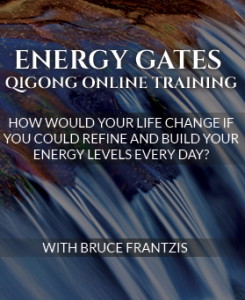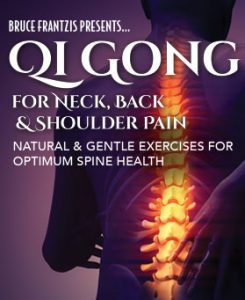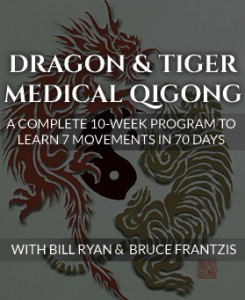By Senior Energy Arts Instructor Paul Cavel
Although internal arts practice and the process of embodying ever-deeper layers of neigong is a lifetime pursuit for the most dedicated
practitioners, at each increment of advancement, the associated health benefits increase significantly. Many students will sacrifice content for form, but it is the internals that supercharge qigong, tai chi and bagua forms—that which makes all the power-generating and health benefits possible.
Neigong training starts with physical movements that stretch the body’s soft tissues (muscles, fascia, tendons and ligaments) through various systematic and progressive techniques. Stage two is all about learning how to manipulate the body’s fluids which, with sustained practice, can eventually allow practitioners access to the energy that powers the body. In the third stage, the mind’s intent can be applied to move chi at
will, where some would say the fun really begins.
Making the Body Conscious
Exercising the body on three distinct levels—nerves/flesh, fluids and chi—allows you to release both generalised stress and long-term, bound tension at each layer. The ability to manipulate all three at will and on demand is the equivalent to turning a key to unlock the body’s mechanisms that enable deep relaxation because:
- Energy moves fluids (e.g., blood, lymph,
interstitial, synovial and cerebrospinal); fluids move the body. - Energy moves strongest through the nerves and fluids.
- The nerves and fluids operate the body.
Together, the three levels create a positive feedback loop and synergy that can give a person access to ever-deeper levels of their being since
fundamental neigong techniques seek to relax and open the body, enabling you to let go. Each stage of development can take years or even
decades to sufficiently develop. You cannot skip or only understand one layer on a superficial basis yet advance to the next, more complex level with any degree of success. The skill you achieve with each and every component will set the stage for and be contained within the next. So you either multiply or completely unravel the results you can attain at the deeper, more advanced layer. The same is true for your students.
Practitioners on a well-balanced diet of content and form will accomplish four important goals:
- Learn choreography or formwork, from simple to complex.
- Develop specific threads of essential neigong.
- Blend neigong and formwork at ever-greater depths and in more intricate patterns.
- Increase the potential of experiencing power-generating and health benefits—right from the start.
In the early stages of neigong practice, there are two primary streams that are best developed separately and together to gain conscious control over bodily functions, which are:
- Contacting and manipulating the soft tissues;
- Contacting and developing the pulse (open and
close).
Qigong for Beginners: Soft Tissue Work
There are five distinct layers to consider when working with the soft tissues, where each is a progression from and expands upon the depth offered in the previous layer.
The five levels for working with the soft tissues are:
- Bending and stretching from the outside in and the inside out;
- Lengthening along the yin and yang surfaces of the body, and
wrapping the soft tissues of the torso; - Turning or rotating the arms, legs and torso;
- Twisting the soft tissues;
- Spiraling the soft tissues.
Hierarchy for Developing Your Soft Tissues
As with the entirety of neigong, a training hierarchy dictates the process of learning to manipulate the soft tissues for health and power generation. Within it there are two groups of components or areas of development for moving the soft tissues.
The two groups, with their specific sequence of learning, are:
- Bending and Stretching (Basic);
Lengthening/Wrapping (Intermediate) - Turning/Rotating (Basic);
Twisting (Intermediate); Spiraling (Advanced)
You must start with bending-stretching and rotating because these methods:
- Form the foundation for the more advanced work.
- Allow you to gain some control over your soft tissues,
which in turn allows you to advance to the next
stage. - Begin the process of making your body conscious.
Achieving the above is among the first steps you must take to literally put your mind inside your body to contact and bring alive your body’s soft tissues. Embodiment of these essential neigong is part of your foundation—regardless of which internal art(s) you practice. Gaining conscious control over the soft tissues with your mind’s intent is an introductory method that can evolve into the ability to manipulate and cultivate chi.
Simple, Repetitive Qigong Exercises
First and foremost, you must practise simple repetitive qigong exercises rather than complex tai chi or bagua forms to have any chance of embodying neigong. That is, unless you are a genius in mind-body-chi, which is very, very rare. Circle Walking is also good because it adheres to the simple-and-repetitive-movement requirement. When I began training with Bruce, I spent nine years—every possible waking moment—developing my practice at this fundamental level. I spent three years practising Energy Gates Qigong daily before attempting the Third Swing. This slow approach allows stability and depth in each technique before adding the next, more complete piece.
Once you’ve developed any given technique to the point where it is literally (not figuratively) in your flesh, then and only then would you apply it to more complex forms, such as bagua and tai chi.
Bending & Stretching in Neigong
The initiation of soft tissue work starts with bending and stretching through the five bows of the body: arms, legs and torso. A primary emphasis in bend and stretch is learning to adhere to the golden mean and neither bending nor stretching more than 70% of your capacity. Otherwise, blood and chi flow will be restricted or even temporarily shut down.
For example, the ideal would be to bend the arms to 70% and leave a 30% reserve, or stretch to 70% and leave a 30% bend in the arms. This comfortable range of motion also keeps the body connected and relaxed, whereas either bending or stretching too far will break the connection between the limbs and body (spine and torso), and spike your nervous system.
Within the proper parameters (unique to each individual), bending and stretching allows you to delve inside your body, release stuck tissues and connect your limbs to your spine, making integrated, whole-body motion possible. In time and with practice, you can loosen and release residual tension inside your body along with the pain and suffering that often accompanies it. Bending and stretching provides an exit pathway to release and let go of that which binds and restricts the body—an absolute prerequisite for practising deeper and more powerful twisting methods.
One point to look for in your students is the balance between the arms and legs. Often times, the range of physical bending in the arms is far greater than that in the legs, yet both remain connected and in continuous motion. That is all four limbs start to bend simultaneously, changeover to the stretch simultaneously and finish simultaneously. The timing sequence is critical to catch the flow, so be sure to demonstrate the different ranges of motions to give students a visual input: first show only the arms, then only the legs, and finally both together. Repeat that sequence several times.
Circling Hands and tai chi’s beginning form (first move) are excellent for embodying the principle of bend and stretch. They also work great as short courses for beginners since it will help wake up their soft tissues and prepare them for more advanced lengthening techniques, which require far more control, only gained by a much greater degree of communication between the mind and body.
Turning & Twisting
Turning and twisting are closely related, so much so that they are essentially two levels of the same game. In turning, the rotation of a limb is initiated through activation of the outer muscles. Whereas, in twisting, the rotation is initiated through activating deeper layers of muscle. In turning the muscles and bones move equally, whereas in twisting the muscles move more than the bones.
Turning Techniques
Turning must be practised for a reasonable period of time because it is gentle on the body and a great method for releasing the nerves, which prepares the body for twisting. If you twist too early—before the nerves are sufficiently released—you can actually trap tension in your body.
It is quite normal for experienced internal artists to begin their practice with an emphasis on bend and stretch with some turning. As the body warms up, becomes better connected and the nerves release, they move on to incorporating lengthening and twisting techniques.
Twisting Techniques
Twisting engages the vascular system more fully and deeper than bending and stretching and turning, but relies upon the bend-stretch and turning preliminaries. So the more you prepare your body with bend-stretch and turning, the more potential benefit you will gain when you upgrade to twisting.
Copious practice of twisting will give you excellent control over your soft tissues, loosening everything off the bones and creating a soft, supple, relaxed and strong body. Twisting alone can help you fine tune your form(s), and engage and amplify the circulation of fluids while deeply
massaging your internal organs. Finally, as the soft tissues are twisted progressively more deeply (over months and years), it is possible to release and eliminate ever-deeper layers of blockages and toxins, perhaps lodged in the body for years or even decades.
Developing real skill in twisting contributes to a healthy body. So get your practice up to this intermediate level and be content to stay there for a long time—until you are well prepared for the advanced material. Complete and even twisting throughout the body that is deeply connected is a preliminary for spiraling the soft tissues, which, again, gets a lot trickier.
Spiraling Techniques
Spiraling puts an enormous pressure into the origination and insertion points of the muscles, so strain or tearing is likely. That is unless you have trained properly and adequately, while under the guidance of a very experienced instructor. Advanced spiraling material is rarely taught because too few people have sufficiently developed their bodies with twisting methods to necessitate the teachings…
Pulsing
Pulsing is a naturally occurring phenomenon replicated time and again throughout the universe as an essential aspect of every living organism, including human beings. Pulsing (also known as “opening and closing”) is little more than a synchronised, alternating rhythm of expanding and condensing energy.
In terms of qigong, tai chi and bagua, the concept of pulsing is simple: You want your entire body and its energy to pulse as one
coherent whole throughout your form (set, style or palm change). The theory is relatively easy to understand, but in practice there are many layers to pulsing that require patience and dedication to achieve. Fundamentally, pulsing can become a means by which you work through all the body’s primary systems and subsystems to restore balance and connection in the totality of your being.
If you look at a healthy baby, there are two very obvious currents that run through its soft, supple and vibrant body: spirals and pulsations. Spirals can be directed by soft tissue work while pulsations are initially directed by the opening and closing of the body’s joints and cavities.
However, it does not stop there. Eventually, you can pulse everything in your body, including your internal organs, glands, soft tissues and subtle energy anatomy.
Pulsing to Contact Your Chi
The joints are typically the easiest place to start for most students since it only entails one focal point—trying to increase and decrease the space between the bones in an alternating rhythm.
At this level, a tangible sense of the pulse in the joints has many generalised health benefits, including:
- Releases the nerves.
- Fosters a sense of relaxation by expelling surface-level and deeply bound tension.
- Stretches open the ligaments and thereby engages synovial fluid (lubricating fluid
between the joints). - Becomes a means by which you can contact the energy gates at the centre of the
joints that govern your physical body. - Serves as a gateway for initiating the pulse with your mind’s intent and taking
the pulse yet deeper into your body.
As with all neigong, initially you seek to manipulate the physical body and with regular, dedicated practice, you can eventually gain
access to the energy that powers it.
Pulsing is a highly effective, intermediate neigong technique for going through the physical body to contact your energy via your
fluids. Activation of the fluids is the critical link that helps you make the jump to accessing and directing your chi in your qigong, tai chi or bagua practice.
In the Water method practices we teach, the process of “ice to water, water to gas” is a means for dissolving blocked energy. However, ice to water, water to gas can also serve as a metaphor to access ever-more subtle layers of your being from:
- Solid—your physical bones and flesh; to
- Liquid—bodily fluids (which in the case of pulsing the joints, would be synovial fluid);
to - Gas—whereby you gain access to the chi that powers you as a living organism.
How to Learn to Pulse (Open-Close)
There is really only one way to learn how to pulse: Have a well-trained practitioner put their hands on your body and manipulate it to create a pulse at such a gross level that you can easily recognise it. Then, over time, you seek to replicate that experience in your own body. You could do all sorts of mental gymnastics and visualising, but it will get you no closer to actualising the pulse than thinking about food can provide nourishment and feed your hunger.
Over the last 16 years, I’ve taught the subject of pulsing and, often times, find that even students who have some knowledge and experience with the pulse are stumped for words when I activate a gentle yet clear pulse throughout their body (or in some localised region). The reason is that any mental construct or anything you could imagine at all is no substitute for the real experience. As with all chi practices, pulsing techniques are done at a subtle level.
However, once you have the experience, you can tangibly tune into and feel the body’s natural openings and closings, and amplify them
yourself. With diligent practice and live training, almost anyone has the ability to gain some faculty in pulsing.
Pulsing the Joints: The Middle Ground
In the beginning, pulsing the joints is usually easiest in the wrists, hands and fingers. Developing your capacity to pulse these joints, and teaching your students to do the same, provides a contact point from which to grow your understanding and skill level.
Next, progress to the ankles, feet, elbows, knees, shoulders, hips, and eventually all the joints of the body, including: the pelvis, ribcage, spine and plates of the skull. At this level, practitioners can get the entire skeleton to pulse, which creates a fantastic synergy that is quite impossible to perceive or imagine without direct experience.
Whether only opening and closing the joints in the limbs (arms and legs) or the entire skeletal frame, you want to bring the pulse up to its maximum operating range, balance the system and then work on deepening it.
Increasing range of motion in the joints releases tension in the ligaments and begins the process of activating the synovial fluid. With practice, this is the layer at which a very springy, spongy body can be created—one that can more easily absorb and withstand shock.
Pulsing for Beginners: Circling Hands Qigong
Once the pulse is open and clear, the next step is to balance it throughout the physical body. This is normally done through Circling
Hands, an easy, repetitive motion that allows the mind to focus on content rather than the form.
Through practice of Circling Hands, the process is simple: compare the pulse in the joint on the left side to the corresponding joint on the right side of your body, and make them equal. This is done by reducing the joint with the larger range to that of the joint with the smaller range (i.e., adhering to the 70% rule and not overstraining the weakest link).
Go through all pairs, e.g. hands, feet, elbows and knees. Next, compare each pair to all other pairs, e.g. hands to feet, elbows to knees, shoulders to hips, and equalise any imbalances.
By reducing your range of motion to the joint with the smaller range, you can:
- Dramatically soften the pulse;
- Release the nervous system;
- Deepen the pulse in the joints;
- Link the pulsing of the joints into one unified lattice, thereby amplifying the
positive effects of the pulse.
Once the outer frame is activated as one whole, balanced and integrated, you are on the road to creating a real synergy throughout your entire system. At the level of pulsing the joints, the results can be quite profound, but from the perspective of neigong your vehicle is only in first gear.
Pulsing is an evolving technique that morphs and changes in application as your body and the ability to directly influence your energy develop. The more dramatic, broad-ranging and long-lasting results reveal themselves after the tuning in period, when you can go deeper than only pulsing the joints and gain some faculty in opening and closing your body’s cavities.
Pulsing the Cavities: The Game Changer
If your approach is methodical and you take the time necessary to achieve a well-balanced pulse in all your body’s joints, you will
naturally begin to activate the cavities. This is where the game shifts.
From the perspective of pulsing, the skeletal frame is considered the shell or container. If you want to go internal, however, you must penetrate the shell. That is you must go deeper inside your body to activate and engage the cavities to powerfully increase circulation of fluids and chi throughout the body.
Most of the cavities are located in the torso, which govern and feed the joints. A cavity is basically made up of soft tissue that is engorged with interstitial fluid. There are no bones in a cavity (unlike a joint), so the pulse can go spherical rather than only linear (as is the case with a
joint).
In addition to the cavities that are deep within the torso, there are also cavities at the roots of each limb: the armpits for the arms, the kwa for the legs and the throat notch for the neck and head.
Activating the Spherical Pulse
So here we have two interesting coincidences:
- The cavities, being made of only flesh and fluid, act like a strong pump that drives interstitial fluid around the body. As the largest reservoir of fluid in the body, interstitial fluid not only lubricates all the soft tissues, but also facilitates the transfer of all nutrient and waste byproducts between the blood and cells.
- Since there is a major cavity at the root of each limb, when activated it both circulates interstitial fluid and chi down the limb and back, as well as supercharges the pulse in the joints of that limb.
So the cavities pulse, boosting circulation of bodily fluids and chi, and thereby further engage the joints—kicking the pulse up a gear. The quality of motion in the body takes on a life of its own, creating an incredibly relaxed, deep and viscous alternating rhythm. At this level of the game, your body begins to mimic the action of a jelly fish or a squid, a spherical pulsing, boneless motion that has no obvious beginning or end. With
this, you have an internal practice.
Incorporating Introductory Neigong Techniques
into Your Practice & Your Teaching
For serious internal arts students, the depth and complexity of the neigong system is precisely what attracts them to and fascinates them about our system. Each of the 16 neigong represents cosmic potential for developing the body, mind and chi—all capable of producing seemingly mysterious and enigmatic results.
However wacky and incomprehensible some of this material can seem to the casual observer, the neigong system is firmly rooted in concrete, tangible and progressive training techniques that start with developing the physical body. This is what makes the Water method and the Energy Arts System truly extraordinary and safe!
For example, you can bring the wow-factor to your class just by choosing a student and pulsing their wrist for a few minutes while talking theory. Within a few moments, that student (like many before) will likely be visibly less tense with a softer, more relaxed facial expression. How better to make the point: You feel better and it’s good for you?!
Even introductory neigong are not learned from a casual understanding though. You must be dedicated, persistent and patient. Over the years, I’ve also found that most students hyper focus on forms and are generally not clear about the best strategies for building their foundation in neigong.
The distinct layers that come into play when working your way through the foundational neigong are so important because you could be downgrading potential power-generating and health benefits that could be yours for the same practice time. The ideal learning progression and the benefits associated with each layer will not only save you loads of training hours, but more importantly, allow you access to your core energy—where the releasing and letting go can lead to amazing transformations in body, mind and chi.
Keep your practice alive and well, and it’ll do the same for you…and hopefully your students!
Paul Cavel began training the Energy Arts System in 1987, after suffering serious injury from a motorcycle accident. After more than two decades of training, he has not only healed his injuries, but teaches as one of only 12 senior instructors in his teacher’s system. Since 1995, Paul has taught seminars and retreats, and offered personal training to help people achieve their personal goals. Paul offers an integrated health, fitness and stress-management solution to give your body all the exercise it needs while releasing blockages in your mind-body-chi that hold you back from realising your true human potential. Read more articles like this one at https://www.paulcavel.com/





0 Comments